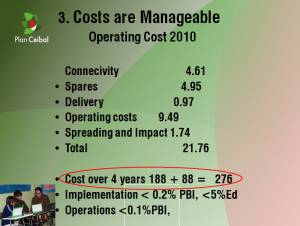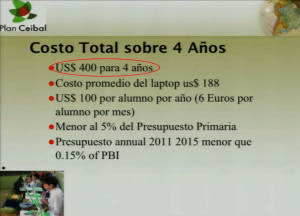A couple of weeks ago I mentioned a great presentation which Plan Ceibal's president Miguel Brechner gave at a festival in Madrid in early October. Upon re-watching it over the holidays I caught an interesting detail which I had previously missed: The figure for Plan Ceibal's 4-Year Total Cost of Ownership (TCO) went up from $276 to $400 over the last two years.
The first slide below is taken from a presentation which Brechner gave in Washington, D.C. in late 2009:

Red circles added for emphasis.
The second slide comes from the aforementioned talk in Madrid in early October 2011:

Red circles added for emphasis.
I'm not surprised about this increase and had actually expected it as I outlined in a message to a colleague regarding the $276 figure back in May of 2011:
Personally I'd take this number with a grain of salt as it's from relatively early on in the project and seeing how Plan Ceibal has changed in many ways (e.g. different maintenance system, more extensive teacher training, etc.) I would assume the current figure to be higher.
Speaking to some Plan Ceibal folks about this they also explained that besides the changes mentioned above there have also been significant investments in fibre optic Internet connections for urban schools, a system for managing educational content, a digital library, and the expansion of the project to secondary schools.
Considering the fairly recent expansion of Plan Ceibal's new maintenance system and its many other 2011 plans (e.g. around robotics and online evaluations) it's quite possible that this figure will continue to increase, at least a little bit.
I would really like to see comparable data from other OLPC and 1-to-1 projects which have been going on for several years. It's not like we haven't had a lot of discussions about the TCO of such projects here on OLPC News and in many other places. However as an IADB report from earlier in the year points out:
"there is still surprisingly little data on the costs of One‐to‐One models in developing countries" (emphasis added)
Plan Ceibal is in somewhat of a unique position to start providing such data. Therefore it would be great for them to break down that $400 figure and explain how the individual changes and investments impacted educational use. This would enable other countries and initiatives to learn and thereby benefit from Uruguay's experiences.


I love the way they publish these data early and often.
Yes, my understanding is that they've increased non-laptop expenses considerably (with better broadband) and repair costs somewhat (as they shifted from self-reporting to regular site visits).
And as Miguel is careful to note, this is still extremely cheap for delivering nationwide broadband; in countries that aren't compact and flat, that would be harder to accomplish at all, and more costly.
Well, unless I'm missing something Plan Ceibal doesn't quite publish its data. Rather I would characterize is as Miguel sharing the most basic of cost-related information.
As mentioned in my post I would certainly love to see much more in-depth figures about the cost of the program. Carefully annotated and explained this could be a very valuable resource indeed.
In any case Uruguay certainly has a couple of characteristics going for it which help keep costs down. Beyond the geography aspects you mentioned on the Internet side of things alone one must also consider that:
(a) almost half the country's population live in the Montevideo metro area,
(b) the telco provider ANTEL is owned by the government, and
(c) the networking infrastructure was already quite good before Plan Ceibal
Hi Cristop - although the Australian XO deployments are fairly independent (ie. not a centralized Government supported program) the $400 cost is pretty close to what has been outlined here also FYI.
Oops - should be Christoph of course!
Jonathan, thanks a lot for that data point, much appreciated. Could you maybe share somewhat of a breakdown of that sum, possibly in a guest article?
TCO is always a movable feast. Where should lines be drawn? For example, if OLPC is the catalyst to extend electricity or internet access to a locale, should that be deemed a contributor to OLPC's TCO?
To accurately model and cost TCO is itself an expert and costly undertaking.
I agree that it's a challenge but as repeatedly discussed with different people within and outside of OLPC I think the lack of reasonably well defined metrics, terms, and calculations is really holding ICT4E back. And not just on the TCO front but also in other areas such as monitoring and evaluation.
Working on a common vocabulary and sharing data, imperfect as it may be, within the OLPC community would be a good and important step into the right direction in my opinion.